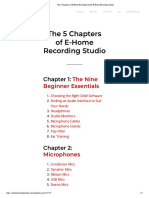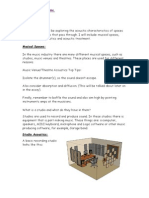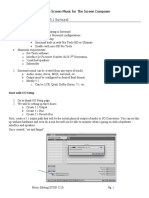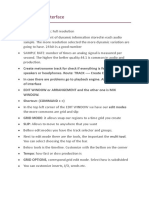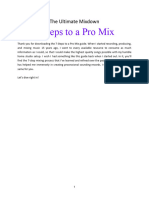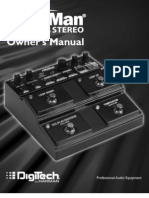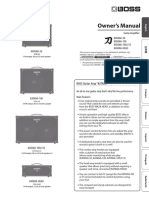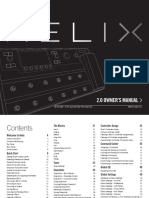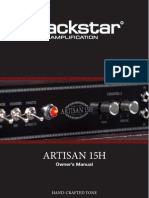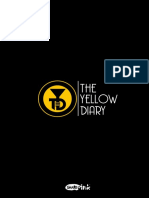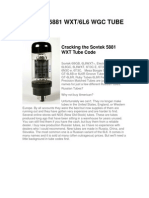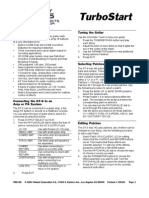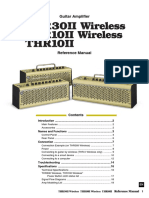AT38 Guitar Amp Mic Technique
AT38 Guitar Amp Mic Technique
Uploaded by
Robert LeeCopyright:
Available Formats
AT38 Guitar Amp Mic Technique
AT38 Guitar Amp Mic Technique
Uploaded by
Robert LeeOriginal Description:
Copyright
Available Formats
Share this document
Did you find this document useful?
Is this content inappropriate?
Copyright:
Available Formats
AT38 Guitar Amp Mic Technique
AT38 Guitar Amp Mic Technique
Uploaded by
Robert LeeCopyright:
Available Formats
Guitar Amp mic technique
Having worked with bands like INXS, AC/DC, Cold Chisel and the Divinyls,
Mark Opitz, suffice it to say, knows a thing or two about recording guitar amps.
Andy Stewart caught up with Mark at Studios 301 in Sydney where he revealed
one of his prized techniques for capturing perfect amplified guitar sounds.
3.
2..
AT|68
1. The critical aspect of this setup is to ensure the mics are placed at right
angles (90) to one another. From above, the two mics form the tip of an
invisible triangle, and this apex must correspond with the centre of the
speaker cone.
2. The distance from the speaker determines the room component in
the overall sound. Closer in achieves a tighter recording, further away
increases the room component heard by the mics.
3. Facing the amp from directly behind the two mics you should be able
to see the centre of the speaker cone through the crack between them. To
accurately see the speaker behind the mesh grille, use a small torch.
hen I interviewed Mark Opitz and Tony Wall last year
about their recently released INXS DVD, Im Only
Looking, I casually asked Mark afterwards if hed be
interested in divulging some of the mic techniques hes used
over the years to record the many famous albums that appear
on his impressive CV. Of course I can, no worries, Id be happy
to, responded Mark, much to my surprise. So for my own edification, and that of the AT readership, I took Mark up on his
generous offer.
Rather than be cagey and secretive about the way he works,
Mark is refreshingly open about sharing his engineering experience. What follows here is the first of several short tutorials that
will appear in AT over the course of the next several issues. The
first of these offerings cuts straight to the heart of good guitar
amp recording technique, and is based on a day-long discussion I
had with Mark at Studios 301 in Sydney, which was kind enough
to allow us the use of the recording space for the day.
Miking Guitar Amps
Mark Opitz: Okay. The first thing I want to show you is my
reliable and, dare I say it, infallible mic technique for capturing
the sound of a guitar amp. After I hit on this technique quite by
accident years ago, my days of placing mics all over the amp
and the room in the blind hope of capturing a magical guitar
amp sound were over. Although I dont expect people to drop
everything theyve been doing for this approach, for those of you
who are less than convinced by your own guitar amp recording
technique, this may be the solution to your dilemma.
I should start by saying that this technique in principle works
regardless of the amp in question, whether it is small or large,
loud or quiet, a Marshall or Fender. Were only using a small,
single-speaker amp for the purposes of this demonstration here
(because thats all we could find kicking around 301!), but this
system is applicable to any amp, whether it be a Marshall quad
box or a Fender Deluxe. The only difference is that if our demonstration amp contained more than one speaker, wed firstly have
to ascertain which of these was the best speaker in the box. But
in this case theres only one so we can skip that process.
Now youll notice weve put a Shure SM57 dynamic in front
of the amp, as well as an AKG C414 large diaphragm condenser
two quite different sounding mics. Our setup involves these
two mics placed at 90 degrees to one another (the 90 degree
angle helps maintain the integrity of the phase relationship).
Unlike most single or multiple mic setups I see people constructing in the studio, youll notice that the two mics are placed on
the imaginary line that marks the centre of the speaker cone. I
do this so were capturing the top end from the centre of the
speaker, but without facing the mic directly at it. Both mics are
effectively at 45 degrees to the top end source whilst directly
facing the body of the speaker cone. That way were capturing
the top end in both microphones but without a sharp, unnaturally
bright edge to the sound that can be produced by pointing the
mic directly at the speaker. Were also facing directly at the
bottom end emanating from the speaker. In an X/Y configuration where the two capsules are exactly the same distance from
the speaker, and inside the radius of the speaker (i.e., closer to
the speaker than the distance from the centre of the speaker to
its outer edge), the mics will effectively be facing the two sides of
the inwardly projecting paper cone. See image 1.
The reason were using two microphones here is one of those
happy accidents I came across in the 80s when I was testing
different microphones. At the time I was using a Sennheiser 421
and an AKG C414. But in the end I found the Shure SM57 worked
better in this setup. Being a dynamic microphone, its mid-range
is very, very good. The AKG C414 condenser complements
the 57 by capturing top end and bottom end that the 57 cant
hear. So the effect youre getting is like a dovetailing of the two
microphone tones. If you want, you can use a Neumann U87 or
a U47 Fet (or any large diaphragm condenser, provided it can
cope with high SPL), but the reason I use the AKG is because
its probably one of the toughest condensers ever made, and as
you know, amps get loud! The AKG also has a 10dB pad on the
microphone, so Ill always pad it down and always at the mic,
never at the desk. If youre dealing with a blisteringly loud amp
like a quad box turned up to 11 you need something thats going
to be able to handle that sort of power. We know the SM57 can
handle it, we see them on stage on amps and drums all the time.
Once the mics are placed in their visually correct position
(never assume that because a mics placement looks right its
going to sound right), make sure theyre working by bringing
them up in the control room monitors panned to the centre
(mono). Once the two mics are at similar volumes in the monitoring, flip one out of phase and fine tune their positioning until
they start to substantially cancel each other out (the out of
phase character should sound thin and horrible compared to the
in-phase tone). Then flip them back in phase and bang, theres
your guitar sound. Ive always found that this particular miking
technique is instantly effective. One thing I cant stand in the
studio is arsing about getting a guitar sound, putting mics here,
there and everywhere, trying different rooms and different mics.
With this setup the sound you get out of the amp is exactly the
same as the one youll get in the control room. And thats always
the hardest part in getting a good amp sound simply capturing
a sound thats true to the amp.
Andy Stewart: Can you describe in plain English why the two
mics are placed at 90 degrees to one another?
Mark Opitz: Its because basically you want the signal hitting
the diaphragm of each microphone at exactly the same time,
i.e., phase coherently. Difference in phase, as most people would
realise, is brought about by a discrepancy in distance between
two or more microphones, a source and its capture different
lengths create different times.
AS: Do these two mics usually act as one in terms of the mix,
i.e., were these mics sub-mixed down to one track on tape in the
past?
MO: Well, thats what I used to do but not so much these days
because youve got lots and lots of tracks in the digital domain
usually but if youre going to analogue tape Id nearly always
send the two mics to one track instead of keeping them separate.
In digital multitracking, where theres typically a plethora of
tracks to work with, there are two things that I often do. One
is, I put them on separate tracks because that enables us even
further manipulation of the phase, by blowing up the wave form
and tightening the in-phase characteristics. Although with this
technique, nine times out of 10 when we blow it up its okay
69|AT
anyway. Another thing I always do now digitally is record a
DI of the sound, but not for re-amping purposes. I do that for
editing purposes. Of course its good for re-amping but more
importantly, if youre editing a guitar track in a digital situation,
to pick up the front and end of the note its much easier to hear it
off a clean DI sound than it is from a heavy distorted sound, and
the waveform is far better represented as well. So, for instance, if
youre editing you can listen to the DI and drag the mic channels
around with it.
AS: When youre miking an amp with several speakers, does this
technique always disregard the other speakers in the cabinet?
MO: Always. Here were using an amp that only has one
speaker. On a quad box, however, its a little different. Youre still
1.
2.
AT|70
only miking the one speaker but the trick with the quad box is to
find the right speaker. Its amazing how many guitar players dont
realise that some of their speakers are not sounding as good as
the others. And that can be determined, once youre experienced
with the technique, before a notes played by examining the hiss
thats coming out of them. Years ago, for example, with AC/DC,
I used to go through their whole rig, trying every Marshall head
and every speaker box. I think every guitarist in the band had
about four Marshall heads and eight boxes and on that particular album, Powerage, I went through and matched every head
against every speaker until I found the right combination. And
thats not every speaker box but every speaker. It took nearly two
weeks to do!
AS: Is this with them in the room waiting for you to hit record?
MO: [laughs] No, no. I had two weeks preparation beforehand,
and thats the whole secret to everything, the only magic trick
preparation. But actually in that particular situation I didnt use
this technique then, I just used a good old Fet 47. That record
predates this technique.
The thing about this X/Y technique is that you can play with
it too as long as you adhere to the principle and play within it.
You can go right up against the centre of the cone or back the
mics away just so long as they remain in an X/Y setup and
centred on the speaker. One of the crucial factors is that the mics
must remain set up in front of the centre of the speaker cone.
Otherwise the technique wont work. Its got to be dead centre,
thats the whole thing. Whats coming out of the centre of the
cone and the edges of the cone has to reach the diaphragm of
each mic at the same time. Thats how you get perfect phase.
And when you look at the setup its actually incredibly simple
and quick, which instils confidence in what the players are doing
and confidence in the engineer.
But sometimes a close-miked amp sound is simply not the
order of the day, and in that situation Ill often add a Neumann
U47 Fet placed at distance to back up this approach, rather than
abandon it altogether. The only reason to add this mic is if youre
trying to get extra room ambience into the sound.
AS: Wouldnt it perhaps be easier just to move the 57 and the
414 back a bit than have that third mic messing up the phase
relationship?
MO: Exactly, but not too far back because youve got to
remember once you start moving back, the focal length of the
speakers going to change. Were relying here on the physical
aspects of the speaker. You can only work in the confines of the
speaker setup, and theres really only a 10 to 20 percent leeway
to work with. You cant drop them back as far as the placement
of the U47. Get a torch, look at the grille, set the mics up so the
centre of the X/Y configuration is right on the imaginary centre
line, turn on the amp, start playing, end of story. Its very simple.
1. The combination of condenser and dynamic mics placed phase
coherently (the same distance from the sound source) in an X/Y
configuration provides a reliable and versatile recording quickly
and easily.
2. An AKG C414 in combination with a Shure SM57 are often used
in this setup, however by interchanging these mics with others a
different tonal character can be achieved. Hi SPL-capable mics are
a must close to the amp!
You might also like
- Mike Deans Mix Tips PDFDocument4 pagesMike Deans Mix Tips PDFkgabomolomo06No ratings yet
- SAE Recording GuideDocument225 pagesSAE Recording GuidesalvaesNo ratings yet
- Frekvencije InstrumenataDocument3 pagesFrekvencije InstrumenataMirza LendoNo ratings yet
- 4 Types of Audio Compressors & When To Use Each of ThemDocument9 pages4 Types of Audio Compressors & When To Use Each of ThemGrupo New Age JdcjelNo ratings yet
- Tube Amp Settings November 2012Document72 pagesTube Amp Settings November 2012Franco Ferrer100% (2)
- Marshall Avt275 User ManualDocument9 pagesMarshall Avt275 User Manualhz138No ratings yet
- Studio Manual (2014)Document8 pagesStudio Manual (2014)James BatesNo ratings yet
- Miking Your ChoirDocument3 pagesMiking Your ChoirHenry EzeiloNo ratings yet
- Overheads MasteringtheArtofRecordingDrums PDFDocument8 pagesOverheads MasteringtheArtofRecordingDrums PDFBurakBeyrekNo ratings yet
- Sound Check 101Document7 pagesSound Check 101Girish SharmaNo ratings yet
- Paul White - Recording GuitarDocument3 pagesPaul White - Recording GuitarMauro PriosteNo ratings yet
- Basic Recording TipsDocument39 pagesBasic Recording TipsEbiyele Olusegun OwoturoNo ratings yet
- Advancedfx2 ReverbDocument4 pagesAdvancedfx2 Reverbmwalshe1983No ratings yet
- Home Recording SecretsDocument3 pagesHome Recording SecretsPP SKRNo ratings yet
- Cla 3a Compressor LimiterDocument10 pagesCla 3a Compressor LimiterAndy Alonso Candela PachecoNo ratings yet
- Studio Sessions Part 2 - Reverb From PDFDocument4 pagesStudio Sessions Part 2 - Reverb From PDFnishilgeorgeNo ratings yet
- SPKR MiK How To Make A Microphone From A SpeakerDocument24 pagesSPKR MiK How To Make A Microphone From A SpeakerdrummergoodNo ratings yet
- D4 - Live SoundDocument6 pagesD4 - Live SoundGeorge StrongNo ratings yet
- Sören Hjalmarsson - Subwoofer CalibrationDocument2 pagesSören Hjalmarsson - Subwoofer CalibrationRicardo KleinNo ratings yet
- #Microphones: A Diaphragm - The Sound Waves Strike The Diaphragm, Causing It To VibrateDocument24 pages#Microphones: A Diaphragm - The Sound Waves Strike The Diaphragm, Causing It To VibrateSebastian VANo ratings yet
- Quick Guide To Producer S LingoDocument11 pagesQuick Guide To Producer S LingoLpcks L100% (1)
- Internal Mixing PDFDocument54 pagesInternal Mixing PDFAlejandro RubilarNo ratings yet
- Mixing Checklist: Step 1 - Organize Your SessionDocument4 pagesMixing Checklist: Step 1 - Organize Your SessionmarcelloamalfiNo ratings yet
- How To Create A 3D MixDocument1 pageHow To Create A 3D MixYouremotionalstateNo ratings yet
- Soundbytes Mag: Patch Design For DivaDocument8 pagesSoundbytes Mag: Patch Design For DivaMichael WeinsteinNo ratings yet
- Melodyne Cheatsheet: Which Version of Melodyne Should You Buy?Document4 pagesMelodyne Cheatsheet: Which Version of Melodyne Should You Buy?francoNo ratings yet
- The Home Mastering Guide - Part 3Document7 pagesThe Home Mastering Guide - Part 3Felix VentourasNo ratings yet
- Basslane ManualDocument1 pageBasslane ManualDJ ZOWNKNo ratings yet
- Slate Digital Virtual Mix Rack - User GuideDocument80 pagesSlate Digital Virtual Mix Rack - User GuidecemgallNo ratings yet
- The Practice of Mastering PDFDocument64 pagesThe Practice of Mastering PDFUr HenNo ratings yet
- Guide To Dynamics Control!: v1.04! February 20th, 2012!Document13 pagesGuide To Dynamics Control!: v1.04! February 20th, 2012!pestao123No ratings yet
- Mixing Kick & BassDocument10 pagesMixing Kick & BassgreetingspkNo ratings yet
- Kosmas Lapatas The Art of Mixing Amp Mastering Book PDF FreeDocument59 pagesKosmas Lapatas The Art of Mixing Amp Mastering Book PDF FreeĐặng Phúc NguyênNo ratings yet
- Recording, Eq & FX KeywordsDocument7 pagesRecording, Eq & FX KeywordssimonballemusicNo ratings yet
- Slate Digital VerbSuite Classics - User Guide - 2Document27 pagesSlate Digital VerbSuite Classics - User Guide - 2Hernan GonzalezNo ratings yet
- Choosing The Right Reverb "How Best To Use Different Reverbs"Document9 pagesChoosing The Right Reverb "How Best To Use Different Reverbs"adorno5100% (1)
- 1386 9 The Frequency Landscape 2017Document4 pages1386 9 The Frequency Landscape 2017Giles HulleyNo ratings yet
- 7 Pro Tips For LOUDNESSDocument12 pages7 Pro Tips For LOUDNESSAlexandru DuicăNo ratings yet
- Section FourDocument9 pagesSection FourKatie-Marie MorganNo ratings yet
- Basic Mixing II PDFDocument39 pagesBasic Mixing II PDFLeandro RibeiroNo ratings yet
- Mix March 2013Document86 pagesMix March 2013lnds100% (1)
- 20 Tips On Recording VocalsDocument3 pages20 Tips On Recording VocalsPatricia Ann E ANo ratings yet
- 7 Essential Techniques PDFDocument8 pages7 Essential Techniques PDFtomasNo ratings yet
- #1 Microphones 6-195 - Ephraim PDFDocument190 pages#1 Microphones 6-195 - Ephraim PDFflorinf_u100% (1)
- Step Mix by Joe Gilder (ESPAÑOL)Document7 pagesStep Mix by Joe Gilder (ESPAÑOL)ALEJANDRONo ratings yet
- 20 Hot Metal Production TipsDocument3 pages20 Hot Metal Production TipsArtist RecordingNo ratings yet
- Basic Beat Patterns For Ableton Live 9 Drum Rack: Benjamin Ang Electronic Music LabDocument6 pagesBasic Beat Patterns For Ableton Live 9 Drum Rack: Benjamin Ang Electronic Music LabSteveJonesNo ratings yet
- Lessons 06 Surround Mixing 5.1Document8 pagesLessons 06 Surround Mixing 5.1StanNo ratings yet
- Live Sound Tips For BeginnersDocument7 pagesLive Sound Tips For BeginnersMinh NguyenNo ratings yet
- The Pro Tools Interface: Speakers or Headphones. Route: TRACK - Create Click Track of Interface WindowDocument6 pagesThe Pro Tools Interface: Speakers or Headphones. Route: TRACK - Create Click Track of Interface WindowWalter Taboada PonceNo ratings yet
- Q& A Session 01 - NoisiaDocument18 pagesQ& A Session 01 - Noisiapanner_23No ratings yet
- Product Description Michael BentonDocument8 pagesProduct Description Michael Bentonapi-253722555No ratings yet
- 7 Steps To A Pro Mix GuideDocument12 pages7 Steps To A Pro Mix GuideDiasNo ratings yet
- Dynamic ProcessorsDocument29 pagesDynamic ProcessorssoundkatNo ratings yet
- Dynamic Range - Week 4 AssignmentDocument17 pagesDynamic Range - Week 4 AssignmentEduardo MottaNo ratings yet
- Understanding Microphone SensitivityDocument3 pagesUnderstanding Microphone SensitivityEric SkinnerNo ratings yet
- Well Recorded Electric Guitar - Part 1: BeginningDocument4 pagesWell Recorded Electric Guitar - Part 1: BeginningLucidSamples.comNo ratings yet
- Miking Techniques PDFDocument3 pagesMiking Techniques PDFsageozNo ratings yet
- Ac Guitar RecordingDocument9 pagesAc Guitar RecordingJeffery WashingtonNo ratings yet
- JamMan Stereo Manual 18-0707V-BDocument68 pagesJamMan Stereo Manual 18-0707V-Bwaldemirm35No ratings yet
- 08 Acoustic Catalog WebDocument48 pages08 Acoustic Catalog WebShahrin MahatNo ratings yet
- THR CatalogueDocument14 pagesTHR Cataloguel0ngj0hnsilv3r0% (1)
- GP-200 Online Manual en Firmware V1.1.1 220218Document53 pagesGP-200 Online Manual en Firmware V1.1.1 220218Afrizal MuhibudiNo ratings yet
- JOYO 2020-2021 CatalogusDocument38 pagesJOYO 2020-2021 CatalogusrenavillotaNo ratings yet
- Sound On Sound UK - April 2023Document164 pagesSound On Sound UK - April 2023Dan Alexandru100% (2)
- ZOOM g1 Multi Effects Rp.890,000.00: PriceDocument9 pagesZOOM g1 Multi Effects Rp.890,000.00: PriceJose Archie Wansa RamadhanNo ratings yet
- The Most Important Tube in Your Amp? The Phase Inverter!Document3 pagesThe Most Important Tube in Your Amp? The Phase Inverter!Rica TheSick100% (1)
- Quale Amp Jazz Usa?Document9 pagesQuale Amp Jazz Usa?mariopetraccaNo ratings yet
- Behringer LX112 ManualDocument21 pagesBehringer LX112 ManualzerzigNo ratings yet
- GM-800 Reference Manual EnglishDocument22 pagesGM-800 Reference Manual EnglishMike usoNo ratings yet
- BOSS Katana Owner's Manual 2nd EditionDocument13 pagesBOSS Katana Owner's Manual 2nd EditionAlexandru ButurugaNo ratings yet
- Fractal Audio Announces The FM3 Amp Modeler MultiFXDocument2 pagesFractal Audio Announces The FM3 Amp Modeler MultiFXIanni zianNo ratings yet
- FocusStylesReggae and Heavy Rock PDFDocument14 pagesFocusStylesReggae and Heavy Rock PDFAlison Cooper-WhiteNo ratings yet
- Helix 2.0 Owners Manual - Rev D - English PDFDocument59 pagesHelix 2.0 Owners Manual - Rev D - English PDFAloysius JulindraNo ratings yet
- Hand-Crafted Tone: Owner's ManualDocument29 pagesHand-Crafted Tone: Owner's ManuallarryntftwNo ratings yet
- Tyd Av Rider August 2022Document7 pagesTyd Av Rider August 2022Arnav SharmaNo ratings yet
- M Britt Profiles - 2020 Pack InfoDocument7 pagesM Britt Profiles - 2020 Pack InfoweriwulfNo ratings yet
- Acoustic Box 2 ManualDocument17 pagesAcoustic Box 2 ManualAdedejinfoNo ratings yet
- Swells WT Helix Patch ReadMe V2 - 0Document5 pagesSwells WT Helix Patch ReadMe V2 - 0elloproducoesNo ratings yet
- Sovtek 5881 Wxt/6L6 WGC Tube GuideDocument8 pagesSovtek 5881 Wxt/6L6 WGC Tube GuideKon GekasNo ratings yet
- Pedal GEB-7 Boss PDFDocument16 pagesPedal GEB-7 Boss PDFeddietales3766No ratings yet
- GT6 TsDocument2 pagesGT6 Tsgabriel_barragan_5No ratings yet
- Manual Thr10iiDocument20 pagesManual Thr10iiguilleallNo ratings yet
- PAL800 GOLD Overdrive - Owner's Manual - Rev3Document1 pagePAL800 GOLD Overdrive - Owner's Manual - Rev3Philippe BouchardNo ratings yet
- Owner's Manual: How To ConnectDocument4 pagesOwner's Manual: How To Connectjorcos82No ratings yet
- Carvin KB1000-1010-1015Document4 pagesCarvin KB1000-1010-1015Richard UrbanNo ratings yet













